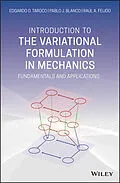Introduces readers to the fundamentals and applications of variational formulations in mechanics
Nearly 40 years in the making, this book provides students with the foundation material of mechanics using a variational tapestry. It is centered around the variational structure underlying the Method of Virtual Power (MVP). The variational approach to the modeling of physical systems is the preferred approach to address complex mathematical modeling of both continuum and discrete media. This book provides a unified theoretical framework for the construction of a wide range of multiscale models.
Introduction to the Variational Formulation in Mechanics: Fundamentals and Applications enables readers to develop, on top of solid mathematical (variational) bases, and following clear and precise systematic steps, several models of physical systems, including problems involving multiple scales. It covers: Vector and Tensor Algebra; Vector and Tensor Analysis; Mechanics of Continua; Hyperelastic Materials; Materials Exhibiting Creep; Materials Exhibiting Plasticity; Bending of Beams; Torsion of Bars; Plates and Shells; Heat Transfer; Incompressible Fluid Flow; Multiscale Modeling; and more.
* A self-contained reader-friendly approach to the variational formulation in the mechanics
* Examines development of advanced variational formulations in different areas within the field of mechanics using rather simple arguments and explanations
* Illustrates application of the variational modeling to address hot topics such as the multiscale modeling of complex material behavior
* Presentation of the Method of Virtual Power as a systematic tool to construct mathematical models of physical systems gives readers a fundamental asset towards the architecture of even more complex (or open) problems
Introduction to the Variational Formulation in Mechanics: Fundamentals and Applications is a ideal book for advanced courses in engineering and mathematics, and an excellent resource for researchers in engineering, computational modeling, and scientific computing.
Autorentext
EDGARDO OMAR TAROCO, PHD, was a Full Researcher at the National Laboratory for Scientific Computing (LNCC/MCTIC) and at the National Institute of Science and Technology in Medicine Assisted by Scientific Computing (INCT-MACC), Petrópolis, Brazil.
PABLO JAVIER BLANCO, PHD, is a Full Researcher at the National Laboratory for Scientific Computing (LNCC/MCTIC) and at the National Institute of Science and Technology in Medicine Assisted by Scientific Computing (INCT-MACC), Petrópolis, Brazil, and Associate Professor at the Catholic University of Petrópolis, Brazil.
RAÚL ANTONINO FEIJÓO, is a Full Researcher at the National Laboratory for Scientific Computing (LNCC/MCTIC) and at the National Institute of Science and Technology in Medicine Assisted by Scientific Computing (INCT-MACC), Petrópolis, Brazil.
Inhalt
Preface xv
Part I Vector and Tensor Algebra and Analysis 1
1 Vector and Tensor Algebra 3
1.1 Points and Vectors 3
1.2 Second-Order Tensors 6
1.3 Third-Order Tensors 17
1.4 Complementary Reading 22
2 Vector and Tensor Analysis 23
2.1 Differentiation 23
2.2 Gradient 28
2.3 Divergence 30
2.4 Curl 32
2.5 Laplacian 34
2.6 Integration 35
2.7 Coordinates 38
2.8 Complementary Reading 45
Part II Variational Formulations in Mechanics 47
3 Method of Virtual Power 49
3.1 Introduction 49
3.2 Kinematics 50
3.2.1 Body and Deformations 50
3.2.2 Motion: Deformation Rate 55
3.2.3 Motion Actions: Kinematical Constraints 61
3.3 Duality and Virtual Power 66
3.3.1 Motion Actions and Forces 67
3.3.2 Deformation Actions and Internal Stresses 69
3.3.3 Mechanical Models and the Equilibrium Operator 71
3.4 Bodies without Constraints 74
3.4.1 Principle of Virtual Power 75
3.4.2 Principle of Complementary Virtual Power 80
3.5 Bodies with Bilateral Constraints 81
3.5.1 Principle of Virtual Power 81
3.5.2 Principle of Complementary Virtual Power 86
3.6 Bodies with Unilateral Constraints 87
3.6.1 Principle of Virtual Power 89
3.6.2 Principle of Complementary Virtual Power 92
3.7 Lagrangian Description of the Principle of Virtual Power 94
3.8 Configurations with Preload and Residual Stresses 97
3.9 Linearization of the Principle of Virtual Power 100
3.9.1 Preliminary Results 101
3.9.2 Known Spatial Configuration 102
3.9.3 Known Material Configuration 102
3.10 Infinitesimal Deformations and Small Displacements 103
3.10.1 Bilateral Constraints 104
3.10.2 Unilateral Constraints 105
3.11 Final Remarks 106
3.12 Complementary Reading 107
4 Hyperelastic Materials at Infinitesimal Strains 109
4.1 Introduction 109
4.2 Uniaxial Hyperelastic Behavior 109
4.3 Three-Dimensional Hyperelastic Constitutive Laws 113
4.4 Equilibrium in Bodies without Constraints 116
4.4.1 Principle of Virtual Work 117
4.4.2 Principle of Minimum Total Potential Energy 117
4.4.3 Local Equations and Boundary Conditions 118
4.4.4 Principle of Complementary Virtual Work 120
4.4.5 Principle of Minimum Complementary Energy 121
4.4.6 Additional Remarks 122
4.5 Equilibrium in Bodies with Bilateral Constraints 123
4.5.1 Principle of Virtual Work 125
4.5.2 Principle of Minimum Total Potential Energy 125
4.5.3 Principle of Complementary Virtual Work 126
4.5.4 Principle of Minimum Complementary Energy 127
4.6 Equilibrium in Bodies with Unilateral Constraints 128
4.6.1 Principle of Virtual Work 128
4.6.2 Principle of Minimum Total Potential Energy 128
4.6.3 Principle of Complementary Virtual Work 129
4.6.4 Principle of Minimum Complementary Energy 130
4.7 MinMax Principle 131
4.7.1 HellingerReissner Functional 131
4.7.2 HellingerReissner Principle 133
4.8 Three-Field Functional 134
4.9 Castigliano Theorems 136
4.9.1 First and Second Theorems 136
4.9.2 Bounds for Displacements and Generalized Loads 139
4.10 Elastodynamics Problem 144
4.11 Approximate Solution to Variational Problems 148
4.11.1 Elastostatics Problem 148
4.11.2 HellingerReissner Principle 154
4.11.3 Generalized Variational Principle 156
4.11.4 Contact Problems in Elastostatics 158
4.12 Complementary Reading 162
5 Materials Exhibiting Creep 165
5.1 Introduction 165
5.2 Phenomenological Aspects of Creep in Metals 1...
